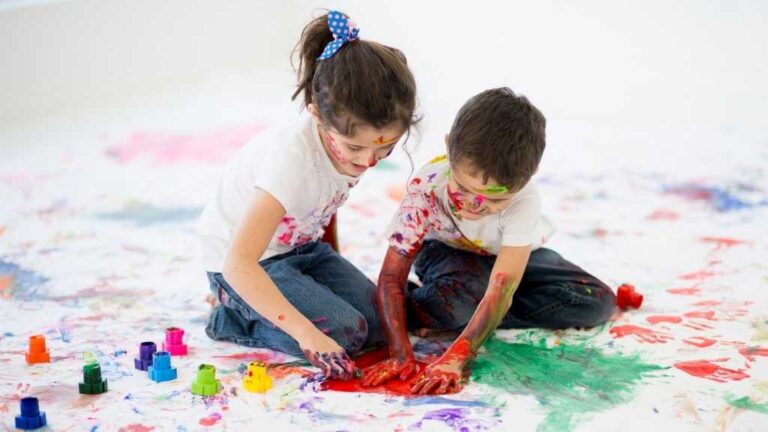Art therapy for autism is widely incorporated into therapy plans to help individuals with autism improve their behavior through expression. The experience of expressing yourself through art is a widely practiced form of therapy that brings a sense of serenity and calmness to most people. Using art within a therapeutic setting is known as “art therapy.” Art therapy for autism continues to improve neurodivergent lives by offering them a powerful way to use their voice and process the challenges associated with this complicated condition.
Art Therapy and Autism
Currently, there exists no cure for autism, but there are some therapies, such as Applied Behavioral Analysis (ABA), that help to shape behaviors through a system of consequences and rewards. Art therapy can be an effective means for individuals with autism to decompress and express their experiences. For many, art therapy for autism is a complementary treatment to a behavioral program like ABA therapy.
Art is especially beneficial for individuals with autism and other sensory processing issues. This is because many people with autism can experience sensory input processes better when non-verbal activities are included. Tremendous joy and wonder are involved in teaching children art therapy for autism.
For many, it becomes a profound tool for coping with life. Art opens their worlds in unique ways and makes confusing emotions more accessible. For children with autism, developing a sense of expression and creativity is a fantastic way to help them with personal development and growth.
8 Benefits of Art Therapy for Autism
Individuals with Autism Spectrum Disorder (ASD) can benefit tremendously from art therapy methods. This includes improving eye contact and the relationship between cause and effect. Some individuals with ASD present their abstract concepts and dynamic memory through paintings. Additionally, art therapy for autism can aid in improving communication and developing social relationships. Children with autism have talents, and art makes it easier to explore them.
Let’s explore the benefits of art therapy for autism in detail:
1. Experiencing Sensory Stimulation
Because creating art can be an extremely physical and tangible experience, children with autism can find it comforting and safe. Activities can include sculpting with putty, holding paintbrushes, folding or crumpling paper, and finger painting, which can all feel soothing for children on the spectrum.
2. Improving Self-Esteem
The process is just as important as the results when considering the effects of art therapy for autism. Individuals feel a sense of excitement and accomplishment when they finish an art project. For many, creating something unique from start to finish boosts self-esteem. Skills are acquired, and with this increased knowledge, individuals can learn more about what they enjoy the most. This increases a sense of independence and worth, which is vital for those on the spectrum. Autonomy is invaluable for these folks.
3. Increasing Social Interactions
By introducing your child to art therapy or art classes, the individual has an increased likelihood of interacting with other children and adults. Many art therapy activities include listening and communicating with the teacher, peers, and therapist. Your child will have an increased opportunity to develop social skills.
Art therapy for autism can help stimulate or diffuse part of the brain, allowing children on the spectrum to express themselves in nonverbal conversations. For example, children with autism can produce a painting or describe something using symbols or icons. This process can help develop communication directly. It also aids individuals in their thinking process. Art therapy can also increase focus in a child or individuals. Art therapy for autism helps to reduce anxiety and improve emotional development.
4. Developing Motor Skills
Art activities require motor skills if an individual is sculpting, painting, drawing, or shredding. For children with autism, developing these skills can be beneficial later in life and help cultivate independence further.
5. Inspiring creativity
Art can offer some children with autism an effective expressive outlet, especially if they are nonspeaking or have limited vocabulary. By providing them with a new way to express their experiences, you can help your child develop even more skills. As your child explores various mediums and activities, they can zero in on how they want to express their feelings and thoughts. This will be your opportunity to see a visual representation of your child’s inner self.
Autism and art go hand-in-hand. You can further encourage your child’s artistic talent by displaying artwork throughout your house and praising their arduous work.
6. Exploring Emotions
Art therapy for autism is also great for neurodivergent children because emotional stability can sometimes be challenging. Drawing or creating a craft can help children with autism express their feelings through activities like making collages and crafts. This therapy can also work on their endurance and improve their patience when solving a task, helping to enhance their expression of feelings.
7. Training the Nervous System
The nervous system in children with autism is one of the most critical aspects of their emotional and behavioral development. Knowing that multi-sensory experiences can help children with autism build on their feelings while listening and touching. Art therapy improves communication skills and sensory sensitivity during the therapeutic process.
Art therapy for autism additionally corresponds to the unique character and variance of each child with autism while helping promote positive interactions during treatment. Another way the arts help is by regulating the nervous system. A therapist can do this through a sense of touch by using kinetic sand, paint, slime, and other craft materials to help them relax and explore their nervous system.
8. Improving Parental Bonds
Parents and their children bond during their child’s formative years. Art therapy can expand on that bond. Art allows parents to bond with their children by understanding their world perceptions. Group projects with the child can lead to feelings of acceptance and comfort. Check Amazon for terrific books to increase art in your child’s life on the spectrum. Make these new activities a part of home life and together time. Keep note of the activities the child most enjoys and build upon them.
Face-to-face interactions, such as socializing, can be stressful for those on the spectrum and make expressing their thoughts or feelings more challenging. A solution to this would be to focus on the art produced by that person and discuss it to form a better bond.
What Is Art Therapy Exactly?
Art therapy is a form of psychotherapy that utilizes art media as the primary means of communication and expression. In this case, art is not a diagnostic tool but a medium to tackle emotional issues that may be confusing and upsetting. Autism in children has various manifestations. Art therapy for autism can provide security in emotional conflicts by giving individuals an outlet.
Including art in therapy works to encourage mental and emotional growth. Unlike art instruction, art therapy builds upon life skills to promote independence and collaboration. Art is an outlet for self-expression, processing, and creativity.
Visual arts are profoundly impactful in improving cognition, spatial and visual discrepancies, coping, and the development of fine motor skills. Many individuals with autism are challenged in communication and are often visual thinkers. Art therapy fits naturally with autism in that it is expressive and, at the same time, soothing.
ABA Centers of America and Art Therapy for Autism
Autism Spectrum Disorder (ASD) is a general term that characterizes a group of neurological conditions which can vary in severity. The most common deficits associated with autism are:
· Social-emotional reciprocity
· Nonverbal communication in social interactions
· Developing, sustaining, and understanding social relationships
ABA Centers of Americas encourages kids on the spectrum to pursue their passions and follow their dreams! If your child seems interested in art, ask your therapy team to include it in their sessions. It can be a rewarding activity or a way to relax and self-soothe. ABA sessions for your child always include their interests, so they are motivating and fun. ABA therapy plans prioritize what is meaningful and valuable to the child and family.
For more information about evidence-based approaches to behavioral therapy for autism or just want to know more about how ABA therapy help, call us at (772) 773-1975 or visit us at ABACentersFL.com.








